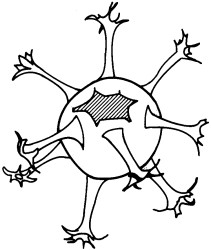Oligosphaeridium complex
*complex (White, 1842, p.39, pl.4, fig.11) Davey and Williams, 1966b, p.71-74. Holotype: White, 1842, pl.4, fig.11, lost according to Davey and Williams (1966b, p.74). Neotype: Davey and Williams, 1966b, pl.7, fig.1, designated by Davey and Williams (1966b, p.71). Originally Xanthidium tubiferum var. complex (Appendix A), subsequently Xanthidium complex (Appendix A), thirdly Hystrichosphaeridium complex, fourthly (and now) Oligosphaeridium complex. Taxonomic junior synonyms: Hystrichosphaeridium elegantulum, according to Deflandre (1946b, p.111); Hystrichosphaeridium himalayense, according to Jain and Garg (1986b, p.64); Oligosphaeridium cephalum, according to Lejeune-Carpentier and Sarjeant (1981, p.9) and Jain (1982, p.52); Geodia? irregularis, according to Harker and Sarjeant in Harker et al. (1990, p.59). Srivastava (1995, p.316) indicated that the epithet should be rendered as "complexum". In Latin, "complexus" is an adjective derived from the verb "complector" (= to embrace, clasp). White (1842) may have been referring to the process endings in this species, which expand distally and may be imagined to reach out to "clasp", in which case the epithet would indeed be properly rendered as "complexum". However, he may have wished to imply the English meaning of the word "complex", believing, incorrectly, that the word also existed in Latin, parallel to Latin words such as "triplex" and "felix", which retain the same ending regardless of gender. Given the uncertainty of White's original intent, and the long-standing stability of the epithet as "complex", we prefer to retain the latter spelling, considering it a "fantasy" or "neo-latin name". (We acknowledge discussion with J. Jansonius, upon which the preceding sentences are based.) Age: Senonian.

</CENTER> Parent: Oligosphaeridium
Infrataxon List: